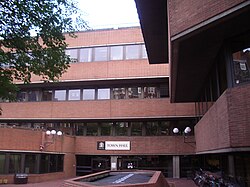
The Royal Borough of Kensington and Chelsea is an Inner London borough with royal status. It is the smallest borough in London and the second smallest district in England; it is one of the most densely populated administrative regions in the United Kingdom. It includes affluent areas such as Notting Hill, Kensington, South Kensington, Chelsea, and Knightsbridge.

A civic center or civic centre is a prominent land area within a community that is constructed to be its focal point or center. It usually contains one or more dominant public buildings, which may also include a government building. Recently, the term "civic center" has been used in reference to an entire central business district of a community or a major shopping center in the middle of a community. In this type of civic center, special attention is paid to the way public structures are grouped and landscaped.
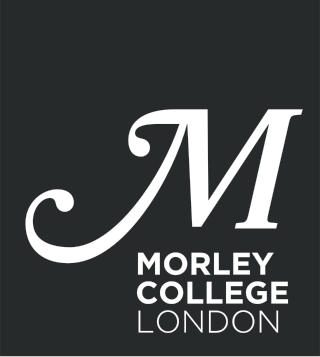
Morley College is a specialist adult education and further education college in London, England. The college has three main campuses, one in Waterloo on the South Bank, and two in West London namely in North Kensington and in Chelsea, the latter two joining following a merger with Kensington and Chelsea College in 2020. There are also smaller centres part of the college elsewhere. Morley College is also a registered charity under English law. It was originally founded in the 1880s and has a student population of 11,000 adult students. It offers courses in a wide variety of fields, including art and design, fashion, languages, drama, dance, music, health and humanities.

Brompton, sometimes called Old Brompton, survives in name as a ward in the Royal Borough of Kensington and Chelsea in London. Until the latter half of the 19th century it was a scattered village made up mostly of market gardens in the county of Middlesex. It lay southeast of the village of Kensington, abutting the parish of St Margaret's, Westminster at the hamlet of Knightsbridge to the northeast, with Little Chelsea to the south. It was bisected by the Fulham Turnpike, the main road westward out of London to the ancient parish of Fulham and on to Putney and Surrey. It saw its first parish church, Holy Trinity Brompton, only in 1829. Today the village has been comprehensively eclipsed by segmentation due principally to railway development culminating in London Underground lines, and its imposition of station names, including Knightsbridge, South Kensington and Gloucester Road as the names of stops during accelerated urbanisation, but lacking any cogent reference to local history and usage or distinctions from neighbouring settlements.
Nicholas Hall Freeman, OBE (1985) was the Conservative Party leader of the London Royal Borough of Kensington and Chelsea Council in the United Kingdom from 1977 until 1989; he was also its mayor in 1988.

Cadogan Group Limited and its subsidiaries, including Cadogan Estates Limited, are British property investment and management companies that are owned by the Cadogan family, one of the richest families in the United Kingdom. They also hold the titles of Earl Cadogan and Viscount Chelsea, the latter used as a courtesy title by the Earl's eldest son. The Cadogan Group is the main landlord in the west London districts of Chelsea and Knightsbridge, and it is now the second largest of the surviving aristocratic Freehold Estates in Central London, after the Duke of Westminster's Grosvenor Estate, to which it is adjacent, covering Mayfair and Belgravia.
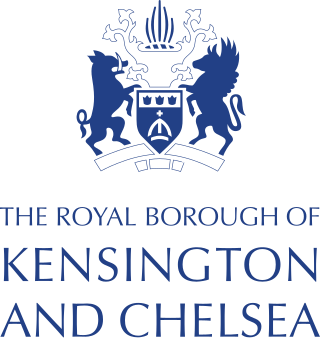
Kensington and Chelsea London Borough Council, also known as Kensington and Chelsea Council, is the local authority for the Royal Borough of Kensington and Chelsea in Greater London, England. It is a London borough council, one of 32 in London. The council has been under Conservative majority control since its creation in 1965. It is based at Kensington Town Hall.
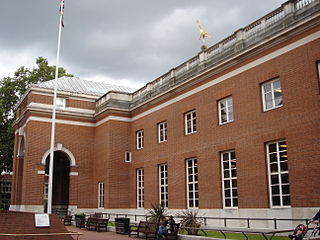
Kensington Central Library is a Grade II* listed building on Hornton Street and Phillimore Walk, Kensington, London. It was built in 1958–60 by the architect E. Vincent Harris on the site of The Abbey, a Gothic house which had been constructed for a Mr Abbot in 1880 and destroyed by bombing in 1944. It was opened by the Queen Elizabeth The Queen Mother on 13 July 1960. The building was designed in a traditional, English, renaissance-style. There were demonstrations against the project by those who advocated for the building to be in a modern style.

Daniel Michael Gerald Moylan, Baron Moylan is an English Conservative politician and a member of the House of Lords.

Sutton Dwellings, also known as the Sutton Estate, are a series of 14 residential buildings in Chelsea, London, U.K.
Emma Dent Coad is a British architectural historian and politician who served as Member of Parliament (MP) for Kensington from 2017 to 2019. A former member of the Labour Party, she has been a member of Kensington and Chelsea London Borough Council since 2006. She resigned her Labour membership on 27 April 2023, but remains on the local council as an independent.

Grenfell Tower is a derelict 24-storey residential tower block in North Kensington in London, England. The tower was completed in 1974 as part of the first phase of the Lancaster West Estate. Most of the tower was destroyed in a severe fire on 14 June 2017.

Lancaster Road (West) Estate is a housing estate in North Kensington, west London.
Nicholas Paget-Brown is an English Conservative politician who was leader of the Kensington and Chelsea London Borough Council. He was first elected as a councillor for Hans Town on 8 May 1986. He became leader of the council on 23 May 2013. On 30 June 2017, he announced that he would step down as leader due to the council's response to the Grenfell Tower fire, and was replaced as leader by Conservative Elizabeth Campbell on 19 July 2017.
Kensington Leisure Centre is a leisure centre located in the North Kensington area of the Royal Borough of Kensington and Chelsea, in London, England. It occupies land formerly considered to be part of the Lancaster West Estate, and was built with the Kensington Aldridge Academy. Both were officially opened by Catherine, Duchess of Cambridge in January 2015.

The 2018 Kensington and Chelsea London Borough Council election took place on 3 May 2018 to elect members of Kensington and Chelsea London Borough Council in England. The election was held on the same day as other local elections in England. While Kensington and Chelsea is usually regarded as a Conservative stronghold, there was media speculation that Labour could win control of the council in the wake of the Grenfell Tower fire. However the Conservatives maintained control, losing just one Councillor, in St. Helen's Ward, winning 36 seats to Labour's 13.
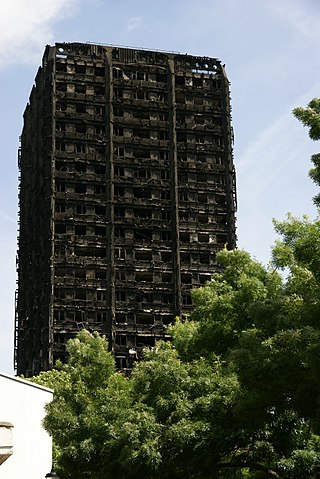
On 14 June 2017, the Grenfell Tower fire broke out in the 24-storey Grenfell Tower block of flats in North Kensington, West London, at 00:54 BST; it caused 72 deaths, including those of two victims who later died in hospital. More than 70 others were injured and 223 people escaped. It was the deadliest structural fire in the United Kingdom since the 1988 Piper Alpha disaster and the worst UK residential fire since the Second World War.
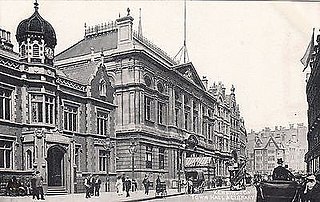
The old Town Hall was a municipal facility at Kensington High Street in Kensington, West London. It was demolished in 1982.
The Grenfell Tower Inquiry is a British public inquiry into the Grenfell Tower fire, which killed 72 people and destroyed Grenfell Tower, residential building in the Royal Borough of Kensington and Chelsea, London, on 14 June 2017. It was ordered by Prime Minister Theresa May on the day following the fire.

The 2022 Kensington and Chelsea London Borough Council election was held on 5 May 2022. All 50 members of Kensington and Chelsea London Borough Council were elected. The elections took place alongside local elections in the other London boroughs and elections to local authorities across the United Kingdom.
